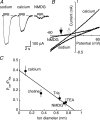Permeation properties of a P2X receptor in the green algae Ostreococcus tauri
- PMID: 18381285
- PMCID: PMC2397467
- DOI: 10.1074/jbc.M801512200
Permeation properties of a P2X receptor in the green algae Ostreococcus tauri
Abstract
We have cloned a P2X receptor (OtP2X) from the green algae Ostreococcus tauri. The 42-kDa receptor shares approximately 28% identity with human P2X receptors and 23% with the Dictyostelium P2X receptor. ATP application evoked flickery single channel openings in outside-out membrane patches from human embryonic kidney 293 cells expressing OtP2X. Whole-cell recordings showed concentration-dependent cation currents reversing close to zero mV; ATP gave a half-maximal current at 250 mum. alphabeta-Methylene-ATP evoked only small currents in comparison to ATP (EC(50) > 5 mm). 2',3'-O-(4-Benzoylbenzoyl)-ATP, betagamma-imido-ATP, ADP, and several other nucleotide triphosphates did not activate any current. The currents evoked by 300 mum ATP were not inhibited by 100 microm suramin, pyridoxal-phosphate-6-azophenyl-2',4'-disulfonic acid, 2',3'-O-(2,4,6-trinitrophenol)-ATP, or copper. Ion substitution experiments indicated permeabilities relative to sodium with the rank order calcium >choline >Tris >tetraethylammonium >N-methyl-D-glucosamine. However, OtP2X had a low relative calcium permeability (P(Ca)/P(Na) = 0.4) in comparison with other P2X receptors. This was due at least in part to the presence of an asparagine residue (Asn(353)) at a position in the second transmembrane domain in place of the aspartate that is completely conserved in all other P2X receptor subunits, because replacement of Asn(353) with aspartate increased calcium permeability by approximately 50%. The results indicate that the ability of ATP to gate cation permeation across membranes exists in cells that diverged in evolutionary terms from animals about 1 billion years ago.
Figures



Similar articles
-
Characterization of cultured dorsal root ganglion neuron P2X receptors.Eur J Neurosci. 1999 Jan;11(1):149-54. doi: 10.1046/j.1460-9568.1999.00426.x. Eur J Neurosci. 1999. PMID: 9987019
-
Functional characterization of a P2X receptor from Schistosoma mansoni.J Biol Chem. 2004 Oct 1;279(40):41650-7. doi: 10.1074/jbc.M408203200. Epub 2004 Aug 3. J Biol Chem. 2004. PMID: 15292267
-
P2X receptors in mouse Leydig cells.Am J Physiol Cell Physiol. 2006 Apr;290(4):C1009-17. doi: 10.1152/ajpcell.00506.2005. Epub 2005 Nov 16. Am J Physiol Cell Physiol. 2006. PMID: 16291815
-
Functional properties of native and cloned P2X receptors.Ciba Found Symp. 1996;198:208-19; discussion 219-22. doi: 10.1002/9780470514900.ch12. Ciba Found Symp. 1996. PMID: 8879827 Review.
-
New structure enlivens interest in P2X receptors.Trends Pharmacol Sci. 2010 May;31(5):229-37. doi: 10.1016/j.tips.2010.02.004. Epub 2010 Mar 11. Trends Pharmacol Sci. 2010. PMID: 20227116 Free PMC article. Review.
Cited by
-
A mechanism of intracellular P2X receptor activation.J Biol Chem. 2012 Aug 17;287(34):28315-26. doi: 10.1074/jbc.M112.372565. Epub 2012 Jun 26. J Biol Chem. 2012. PMID: 22736763 Free PMC article.
-
Evidence for Extracellular ATP as a Stress Signal in a Single-Celled Organism.Eukaryot Cell. 2015 Aug;14(8):775-82. doi: 10.1128/EC.00066-15. Epub 2015 Jun 5. Eukaryot Cell. 2015. PMID: 26048010 Free PMC article.
-
Long-term (trophic) purinergic signalling: purinoceptors control cell proliferation, differentiation and death.Cell Death Dis. 2010;1(1):e9. doi: 10.1038/cddis.2009.11. Cell Death Dis. 2010. PMID: 21364628 Free PMC article. Review.
-
Role of Ca2+ in Mediating Plant Responses to Extracellular ATP and ADP.Int J Mol Sci. 2018 Nov 14;19(11):3590. doi: 10.3390/ijms19113590. Int J Mol Sci. 2018. PMID: 30441766 Free PMC article. Review.
-
ATPe Dynamics in Protozoan Parasites. Adapt or Perish.Genes (Basel). 2018 Dec 27;10(1):16. doi: 10.3390/genes10010016. Genes (Basel). 2018. PMID: 30591699 Free PMC article. Review.
References
-
- North, R. A. (2002) Physiol. Rev. 82 1013-1067 - PubMed
-
- Khakh, B. S., and North, R. A. (2006) Nature 442 527-532 - PubMed
-
- Agboh, K. C., Webb, T. E., Evans, R. J., and Ennion, S. J. (2004) J. Biol. Chem. 279 41650-41657 - PubMed
-
- North, R. A., and Surprenant, A. (2000) Annu. Rev. Pharmacol. Toxicol. 40 563-580 - PubMed
Publication types
MeSH terms
Substances
Grants and funding
LinkOut - more resources
Full Text Sources

